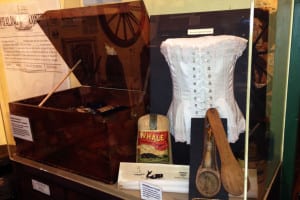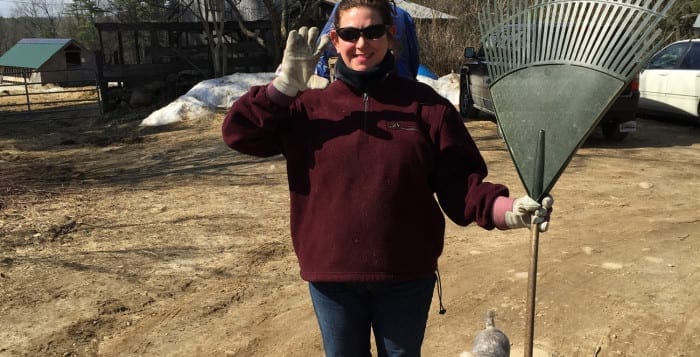By Stacy Santini
This is the third in a four-part series. Miss part two? Read it here.
As epic as this pilgrimage was for me, I would be remiss if I did not consider the impact this all had on my pup. There were numerous Steinbeck moments as my morkie, Charles Crawford, and I greeted each day. It is with complete certainty that I can say I would not have made it through WWOOFing without my little companion. Not only was he a constant reminder of where we came from, but because of him, I was always home and never lonely.
As I delved further into my self, I witnessed Charlie discover parts of his personality I am not sure he knew existed. His patience was tested on a daily basis as he mingled amongst his peers at Owen Farm. While I was out in the pasture, he would spend his time under Ruth’s watch in the kitchen, befriending our fellow WWOOFers’ long-haired black Chihuahua, Shao. After several initial teeth-baring scuffles, they became companions and would follow each other around, exchanging the alpha role frequently.
Dealing with so many different furry personalities, Farmer Chuck learned how to defend himself against a playful, but aggressive, young yellow Labrador named Tucker and how to avoid the predatory, mountain lion-like feline, Pickles. Always leaning toward the side of caution, I was constantly aware of his whereabouts, as Karl the cow and the Arabians were eager to trample little beings in their way. Charlie held his own, but every night as we fell into bed, we both took slumber comforted by knowing our door was locked and it was only the two of us.
Although WWOOFing at Owen Farm was mostly comprised of labor, there were hilarious moments that, to this day, will make me giggle. One morning, when I was wheelbarrowing the hay out to one of the furthest fields, one of my comrades unbridled the horses too quickly. They came charging for me and I just started running back and forth as fast as I could, dumping all the hay to the ground. I must have looked like a player in a PAC-MAN game as I glanced back and caught Camille and Greg rolling on the ground with laughter.
One evening, late at night, as Charlie and I were cuddled up sleeping, we were awoken to the sound of our latch door lock being jiggled. It was pitch black and stillness had settled on the farmhouse hours beforehand. We were frozen with fear and overwhelmed by visions of Freddy Krueger. I was not prepared to meet my death in this manner and finally gained the courage to put the light on and open the door. In front of me stood the largest cat I had ever seen attempting to open the door with his paw. Surreal, to say the very least.
When our time at Owen Farm came to an end, we said our good-byes, travelled a bit, and headed to the foothills of the White Mountains. Patch Farm in Denmark, Maine, was to be our next WWOOF retreat. Swinging to the other side of the pendulum, Patch Farm is a demesne in its infancy, focused on planting and cultivating organic crops. Owned by a passionate young farming couple, BrennaMae Thomas and Brandon McKenney, arriving there was like reaching nirvana when it comes to rural living.
From the exterior, the residence was a quintessential New England country farmhouse. But when you entered, it resembled a SoHo loft. Together, the couple had renovated and created an immaculate art deco space that was not only comfortable, but so aesthetically appealing that it should have been photographed for Architectural Digest. My room, which was large and refreshing, all white, with a fireplace and views of the White Mountain range, was a welcome change to my prior living conditions. We had plenty of running water and were able to shower or soak our weary limbs in the big claw foot tub on a daily basis. This may not seem extraordinary, but trust me, in the world of New England organic farming, it is a luxury.
Complying with my overall experience, this ambience still brought the unexpected. My bedroom was filled with ladybugs. Hundreds of red wings speckled with black spots clung to the plastic covering our windows, reaching for sunlight. At night, they would drop down and become our bed partners. There was something very joyful about living amongst these little beetles.
Outside of the six goats and twelve chickens, Patch Farm is all about growing and sustainable living. My hosts were extremely rousing about their work and breathed, ate and slept farming, but moderation was their motto when it came to WWOOFers. We did not commence our chores until after 7 a.m. and ate a hearty breakfast and only worked until about one or two in the afternoon. The rest of the time was ours to rest, explore, study and enjoy the simplicity of rural living.
Not to say that the work we assumed was not difficult, as it was, but I often felt as though I was at an agricultural college with BrennaMae as my professor. She was extremely knowledgeable regarding all aspects of sustainable living and permaculture. We would be walking amongst the fields and she would start to zealously jump around as she had just noticed some type of clover growing underfoot.
With enthusiasm, she taught us about crop rotation, the benefits of landscape cloths, and major vegetable families and how they work together. In a very short time I was able to identify Allium, Brassica, Cucurbita and Solanaceae genus groups. We planted seeds in their “state-of-the-art” greenhouse and watched as they germinated and cotyledons began to show.
After some time out in the field and our nose in books, such as “The Earth Care Manual: A permaculture Handbook for Britain and Other Temperate Climates” by Patrick Whitefield, BrennaMae gave us an assignment to design her new permaculture herb garden.
Permaculture is about creating edible landscapes that emulate the symbiotic interactions in a natural ecosystem. After hauling rocks into a tractor to clear the fields for planting — a back-breaking endeavor — or attempting to fold up 350 feet of slippery land-covering in mud, I would retreat to the family room to draw blueprints of mandala and keyhole gardens, my contribution to BrennaMae and Brandon’s potential edible oasis.
Although learning to farm was my main objective, I allowed time to travel and investigate the Northeast. With Charlie riding shotgun, my Jeep Patriot carried us from Portland, Maine back to Saratoga Springs and New Paltz and so many places in between.
Like what you’ve read? Check out the final installment here.
Stacy Santini is a freelance reporter for Times Beacon Record Newspapers. Look for her adventures at Patch Farm in Denmark, Maine, in the next issue of Arts & Lifestyles.




































